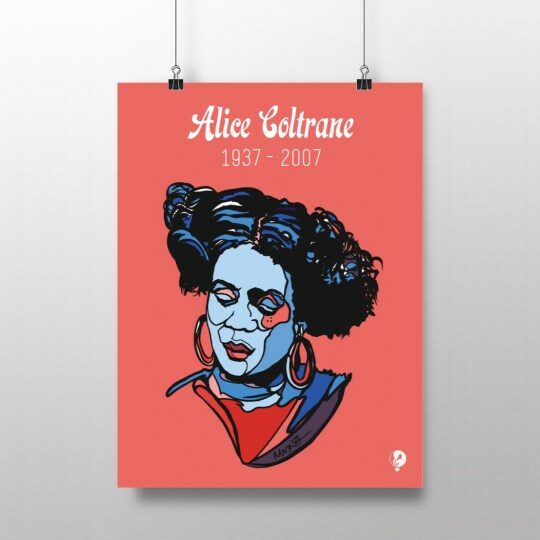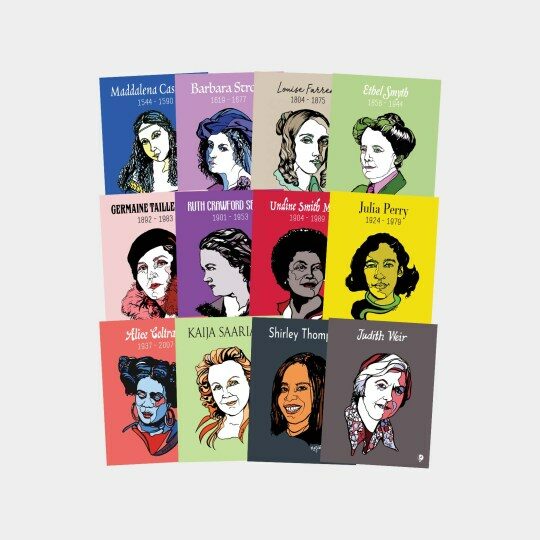
Composer Information
Birth - August 27, 1937 | Detroit, MI, United States
Death - January 12, 2007 | Los Angeles, CA, United States
Nationality - American
Era - Modern
Composer Biography
Written by: Braeden Weyhrich
Alice McLeod Coltrane Turiyasangitananda wore many hats: wife of John Coltrane, mother to four jazz musicians, composer, bandleader, pianist, organist, harpist, and Hindu swamini. She was born in Detroit as the fifth of six children and took up music at a young age. When she was seven years old, she began piano lessons, studying both classical and jazz music. She performed on the piano and organ at her church throughout her childhood. Later, she took up percussion while attending North Eastern High School. Coltrane played for gospel choirs and at jam sessions throughout her teen years, often in a combo alongside her half-brother, bassist Ernest Farrow.
In the late 1950’s and early 60’s, Coltrane spent her time leading and performing in several Detroit-based jazz ensembles. She then briefly moved to Paris, where she married jazz vocalist Kenny Hagood. The couple had a daughter named Michelle, better known as pop and jazz singer Miki Coltrane. After a short marriage, Alice returned to the United States. She toured and recorded with vibraphonist Terry Gibbs, during which time she met famed saxophonist John Coltrane. The couple married in 1965, and Alice became the pianist in John’s quartet following the departure of McCoy Tyner. The Coltranes had three children together, all of whom were musically inclined: bassist John Jr., who died in a car crash in his 20’s; tenor saxophonist Ravi; and alto saxophonist Oran. Alice is featured on six recordings with John and his quartet, where her playing displays an impressive use of the full piano range to showcase modal mixture and dissonance. John died of liver cancer in 1967, just four years after he and Alice first met.
Shortly before her husband’s death, Alice Coltrane began showing an interest in spirituality and Eastern religions. She started meditating, fasting, and working to find her truth. In 1970, she met Swami Satchidananda, also known as “The Woodstock Guru,” and made a pilgrimage to India, where she was called to be a servant of God. At this time, she became known as Turiyasangitananda, which means “the Transcendental Lord’s highest song of Bliss” in Sanskrit. Coltrane moved to California in 1972 and founded the Vedantic Center, a retreat for the study of Eastern religions, in the following years. In 1992, she became the first swamini, or teacher, at the first Hindu temple in the San Fernando Valley. Coltrane wrote four religious texts and recorded several albums of spiritual music that were originally kept private, but were posthumously released for commercial use by her family.
Coltrane’s music was inspired by a variety of sources: “You can really hear all of her influences—it’s like she just put it in a bowl and stirred it up,” said harpist Brandee Younger, who often performs Coltrane’s music alongside her son Ravi as a way to promote her legacy. Coltrane’s music includes gospel influence from her childhood gigs, bebop from her days in John’s quartet, and Sanskrit chanting from her spiritual awakening. Younger said that Coltrane’s music doesn’t fit a genre, and she likes that it doesn’t follow any rules.
Coltrane recorded her last album, the jazz CD Translinear Light, alongside her sons Ravi and Oran in 2004. She died of respiratory failure in 2007 after a long and interesting career. Her life is best summed up in a statement from Ravi: “She was very, very, very unique. A very unique person, you know, and had a life like I would imagine very few people might have.”
See Also
- Berkman, Franya. “Coltrane [née McLeod], Alice [Sangitananda, Turiya].” Grove Music Online. November 26, 2013. https://doi.org/10.1093/gmo/9781561592630.article.A2228112.
- Hazell, Ed. “Coltrane [née McLeod; Sagittinanda, Turiya], Alice.” Revised by Barry Kernfeld. Grove Music Online. January 20, 2002. https://doi.org/10.1093/gmo/9781561592630.article.6002278199.
- “Life.” Alice Coltrane. Accessed July 21, 2021. https://www.alicecoltrane.com/life.
- Ratliff, Ben. “Alice Coltrane, Jazz Artist and Spiritual Leader, Dies at 69.” The New York Times (New York, NY). January 15, 2007. https://www.nytimes.com/2007/01/15/arts/music/15colt.html.
- Tsioulcas, Anastasia. “By Any Name, Alice Coltrane Turiyasangitananda Was A Force.” National Public Radio. May 21, 2017. https://www.npr.org/sections/therecord/2017/05/21/529124610/by-any-name-alice-coltrane-turiyasangitananda-was-a-force.
All Poster Lines
Check Out All Our Poster Lines


